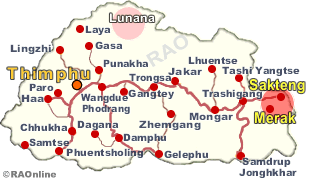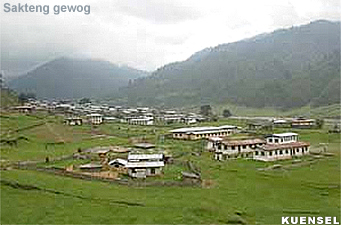|
Bhutan
- Ethnic Groups & People
|
 |
Bhutan's People Merak - Sakten |
|
 |
Bhutan Information |
|
|
 |
 |
|
Electricity expected to reach the highland areas
|
 |
 |
|
Villagers of Merak and Sakteng gewogs in north Trashigang are buying rice cookers, water boilers and TV sets with electricity expected to reach these highland areas by June this year.
Some houses have even done the internal wiring.
"Majority of the work is completed, only stringing the transmission wires remain," the Bhutan Power Corporation manager in Trashigang, Lobzang Dorji, said.
|
|
Sakteng has 380 households and Merak has 260 households.
Gewog officials said they have already transported transformers for Tholong and Joenkhar villages, and are hurrying to transport the others before rain starts. "Once the transformers are in place, it would take less than three days to fix them," Lobzang Dorji said.
The erection of electric poles have been completed in Merak, and stringing of the wires are going on. Stringing is also simultaneously being done in Sakteng.
Though the work, which began in April last year, is being departmentally done, the villagers contribute labour, for which they are paid Nu 150 a day.
Of the 15 gewogs in Trashigang dzongkhag, 13 have electricity, except Merak and Sakteng.
In June 2008, 205 villages had electricity. At the end of the current plan, 258 villages are to be electrified. There are more than 300 households with alternative power source in the dzongkhag.
The government's target is to provide electricity to all households by 2013. Over 40,000 rural households will be electrified during the within the plan period.
Khashithang village under Merak, which was supposed to receive power in the next plan, will be connected in the current plan.
As of now, the residents of these two gewogs live harsh lives, collecting firewood and depending on kerosene for lighting.
"It'll definitely help us stay warm at affordable rates," the Merak community primary school principal, Tashi, said.
Civil servants pay about Nu 8,000 to Nu 10,000 to villagers to collect firewood for heating and cooking, mostly using the bukhari, a wood fed stove.
Villagers said that their lives would change forever.
"The benefits are great. We can save trees as we'd be cooking, lighting, and heating using electric appliances," a villager, Lobzang said.
Sangay Dorji, Sakteng gewog mangap, said work in the offices would also become easy. "It'd also make our services to the people more efficient," Sangay said.
top
| Development
trends |
 |
 |
| Despite
the remoteness of the Merak and Sakteng geogs development trends are being
incorporated. Health and family planning methods are being introduced and
education promoted. Brokpas being semi-nomads initially had no awareness
of family planning. Today, they have access to various family planning
methods like condoms, DMPA, Copper-T, Vasectomy, and Tubectomy but use
still remains low. "The people have come up with the notion of big
family being very important as a large number of children means more hands
for cattle herding," said the study. |
|
"Usage of family planning methods
remains low." Another reason for the aversion to family planning
is the fear of extinction.
According to the study general health conditions
in Merak and Sakteng are affected by imbalanced nutritional intake, poor
sanitation, prevalence of some contagious and infectious diseases.
"The
general health of Brokpas does not seem encouraging since the people still
have not learnt about sanitation and other hygienic health awareness,"
the study said. " This can be accounted by the low level of literacy among
the people and late introduction of the available health facilities." The
study found the most common diseases included diarrhoea, dysentery, respiratory
tract infection, worm infections, skin, eye, teeth and gum diseases as
well as anemia. In Sakteng 18 known cases of STD was also found.
Inroads have also been made in the education sector since the first primary
school in Merak was established in 1987. In 1999 the first group of twelve
Brokpa students appeared for class six common examinations.
Enrolment also
increased to 68 boys and 42 girls. However, according to the study
the great importance attached by the Brokpas to Yak herding has an adverse
impact on the education of their children. Not many parents are keen on
sending their children to school. To ensure the education of this
remote community, admissions have been made compulsory for children aged
seven years and above and irregularity of students to schools are dealt
with a fine of Nu. 10.00. However, the impact of these efforts seem to
have little or no bearing on the attitude, the study found.
The
future
Despite
the rapidly changing socio-economic scenario the Brokpas have always maintained
their uniqueness. However, this "uniqueness" is slowly getting adulterated
by the influx of various elements as a result of modern development process,
the study found. While the government has been making efforts to
bring the Brokpas in line with the pace of development in the rest of the
country the effort has been fruitless because of the low level of response
and acceptance of development activities.

|
| Contributed
by KUENSEL, Bhutan's National Newspaper |
| Information on Bhutan |
 |
|




